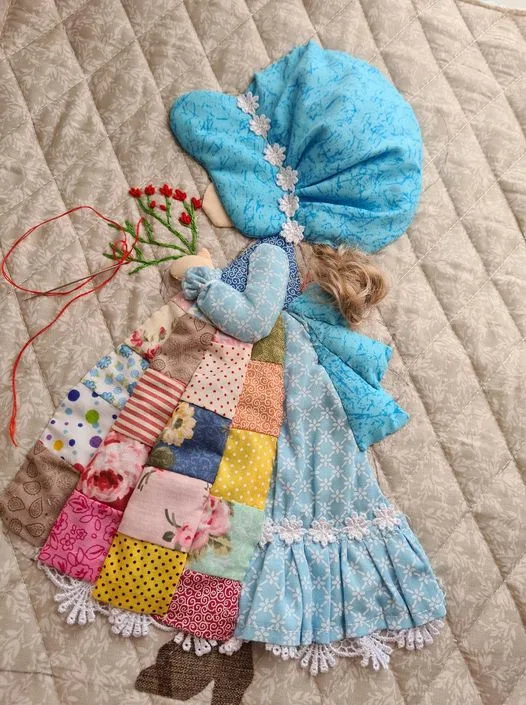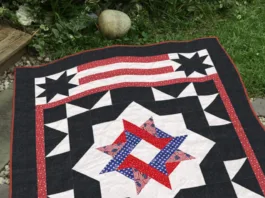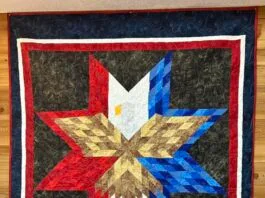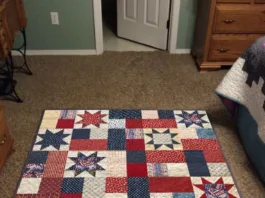The Sunbonnet Sue Block Pattern is one of the most recognizable and beloved designs in quilting. Originating in the late 19th century, this charming pattern depicts a young girl dressed in a bonnet, often with a simple dress and apron, in various poses.
Over time, Sunbonnet Sue has become a classic symbol of innocence and femininity, making it a timeless favorite for quilters worldwide. If you’re interested in creating a quilt using the Sunbonnet Sue Block Pattern, this article will guide you through the steps, tips, and techniques to make the most of this delightful design.
Whether you’re a seasoned quilter or just starting your quilting journey, the Sunbonnet Sue Block Pattern offers a fantastic opportunity to experiment with colors, fabrics, and quilting techniques.

This pattern can be customized in countless ways, making it perfect for a variety of quilt projects, from baby quilts to wall hangings. In the following sections, we’ll explore how to create the perfect Sunbonnet Sue block, select fabrics, and finish your quilt beautifully.
When embarking on your quilting project, it’s essential to understand the elements that make up the Sunbonnet Sue Block Pattern. From choosing the right fabrics to assembling the blocks, this classic design requires attention to detail and a bit of patience.
However, the final result is well worth the effort, as the Sunbonnet Sue design adds a touch of nostalgia and warmth to any home. Now, let’s dive into the details of creating a stunning quilt using this iconic block pattern.
1. Understanding the Sunbonnet Sue Block Pattern Design
The Sunbonnet Sue Block Pattern is known for its charming simplicity, featuring a little girl in a bonnet, often with a basket or other props, standing or sitting in various poses. The design typically includes a figure with a bonnet that covers the face, a dress, and sometimes an apron or other accessories. These blocks can be created using appliqué, embroidery, or piecing techniques, depending on your skill level and preference.
To start, it’s important to understand how to break down the pattern into manageable pieces. The Sunbonnet Sue block is typically made up of two main elements: the girl’s figure and the background. You can choose to create a traditional look by using soft pastel fabrics or opt for modern, bold fabrics for a contemporary twist. The key to a successful Sunbonnet Sue block is to pay attention to the details of the girl’s dress, bonnet, and facial features.
When piecing the blocks together, you can choose to keep the background simple with a solid color or use a more intricate design. Many quilters add borders, flowers, or additional embroidery around the Sunbonnet Sue to make the block more personalized. Some designs include additional elements like hearts or birds, which can be stitched around the figure to create a more whimsical and detailed look.
Another variation of the Sunbonnet Sue Block Pattern includes creating a quilt that features multiple blocks, arranged in a grid pattern. This allows you to showcase various colors and fabric patterns for each block, giving your quilt a lively and colorful aesthetic. Whether you use a traditional or modern twist, the Sunbonnet Sue block is a versatile pattern that allows for endless creativity.
2. Selecting Fabrics for the Sunbonnet Sue Block Pattern
The fabric you choose for your Sunbonnet Sue Block Pattern will play a significant role in how the quilt turns out. Fabrics for the girl’s bonnet, dress, and background should complement each other and provide contrast. Traditional Sunbonnet Sue quilts often feature pastel fabrics for the girl’s dress and bonnet, paired with soft floral prints for the background. These colors evoke a sense of innocence and nostalgia, which is a hallmark of the Sunbonnet Sue design.
However, don’t feel limited to traditional colors. Modern quilters often use bolder, brighter colors to give the Sunbonnet Sue Block Pattern a contemporary feel. Fabrics with geometric prints or vibrant solids can make the block stand out while still maintaining the charm of the original design. It’s also a good idea to use a mix of prints for the dress and accessories to add depth and interest.
When selecting fabric for the background, choose a fabric that doesn’t overpower the Sunbonnet Sue figure. A soft, solid color or a subtle print will allow the girl’s figure to remain the focal point of the block. Additionally, consider using fabrics that will contrast with the Sunbonnet Sue figure to help the block pop. For example, pairing a light-colored girl’s dress with a dark or medium-toned background will make the figure stand out more.
You can also experiment with different textures in your fabric choices. For example, using a slightly textured fabric for the girl’s dress or bonnet, such as linen or muslin, can add a unique touch. For the background, quilting cottons are a popular choice due to their smooth finish and ease of use. Ultimately, the fabrics you select should reflect your personal style and the overall theme of the quilt you wish to create.
3. Techniques for Creating the Sunbonnet Sue Block Pattern
There are various techniques you can use to create the Sunbonnet Sue Block Pattern, depending on your skill level and preferences. The most common method is appliqué, which involves attaching fabric shapes (such as the dress, bonnet, and arms) to a background fabric. Appliqué can be done by hand or with a sewing machine, and it’s the perfect technique for this pattern, as it allows for intricate detailing and clean lines.
If you’re new to appliqué, machine appliqué is a great option. This technique involves using a zigzag stitch or blanket stitch to secure the fabric shapes in place. It’s quicker than hand appliqué and provides a durable finish. If you prefer handwork, you can use a simple hand appliqué stitch or even try the invisible appliqué stitch for a seamless look.
Another option for creating the Sunbonnet Sue Block Pattern is embroidery. You can embroider the details of the dress, bonnet, and face using floss or embroidery thread. This technique adds texture and dimension to the quilt block, giving it a more delicate, artistic feel. Embroidery can also be used to add additional elements such as flowers, birds, or other small embellishments.
For a more traditional approach, you can piece the blocks using patchwork. This involves cutting fabric into shapes (such as squares, triangles, or rectangles) and sewing them together to form the Sunbonnet Sue block. While this method takes more time and effort, it’s a great way to practice your piecing skills and create a quilt that’s both functional and beautiful.
4. Finishing the Sunbonnet Sue Quilt
Once you have completed the Sunbonnet Sue Block Pattern, it’s time to assemble and finish your quilt. The first step is to join the blocks together. Arrange the blocks in a layout that appeals to you, whether it’s in a grid pattern, a random arrangement, or another creative design. Once the blocks are in place, sew them together using a quarter-inch seam allowance.
Next, add borders to the quilt if desired. A border can help frame the quilt and give it a polished, finished look. Choose a fabric that complements the Sunbonnet Sue blocks and enhances the overall design. Borders can be as simple or as intricate as you like, depending on your style and preference.
After the quilt top is finished, it’s time to add the batting and backing fabric. The backing fabric can be a simple solid or patterned fabric, depending on your design. Batting provides the thickness and warmth for the quilt, so choose a batting that suits your desired quilt weight and softness.
Finally, quilt the layers together. You can hand quilt, machine quilt, or use long-arm quilting techniques, depending on your skills and preferences. Quilting adds texture and dimension to the quilt, making the design truly come to life. Once the quilt is quilted, bind the edges with a coordinating fabric to give it a neat, professional finish.
FAQ (Frequently Asked Questions)
1. What fabrics are best for the Sunbonnet Sue Block Pattern? Cotton fabrics are ideal for this pattern because they are easy to work with and come in a wide range of colors and prints. For a traditional look, choose pastels for the dress and bonnet, and soft prints for the background.
2. Can I make the Sunbonnet Sue Block Pattern using machine appliqué? Yes, machine appliqué is a great option for creating the Sunbonnet Sue Block Pattern. It’s faster and more durable than hand appliqué, and you can use a zigzag or blanket stitch for a professional finish.
3. How do I add embroidery to the Sunbonnet Sue Block Pattern? You can add embroidery to the pattern to enhance the details of the dress, bonnet, and face. Use embroidery floss or thread to stitch additional elements like flowers, buttons, or facial features.
4. Can I use other techniques besides appliqué for the Sunbonnet Sue Block Pattern? Yes, you can also use piecing or embroidery techniques to create the Sunbonnet Sue Block Pattern. These methods offer different textures and finishes depending on your preferences.
5. How do I finish the Sunbonnet Sue quilt? Once the blocks are pieced together, add borders, then attach the backing fabric and batting. Quilt the layers together and finish by binding the edges for a professional and polished look.
Conclusion
The Sunbonnet Sue Block Pattern is a timeless design that offers endless creative possibilities for quilters of all skill levels. By choosing the right fabrics, techniques, and finishing touches, you can create a quilt that is both beautiful and meaningful. Whether you prefer traditional methods or want to try modern twists, the Sunbonnet Sue Block Pattern can be customized to fit any style.
We hope this guide has inspired you to start your Sunbonnet Sue quilt. If you have any questions or suggestions, feel free to leave a comment below. Your feedback is always appreciated!




